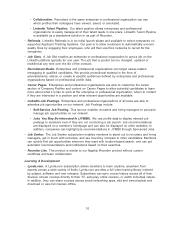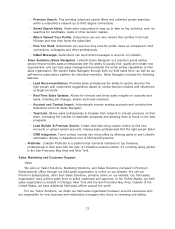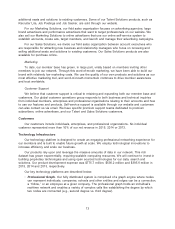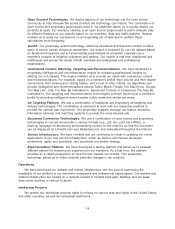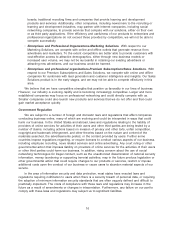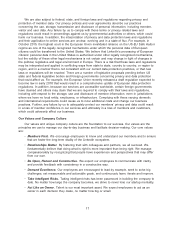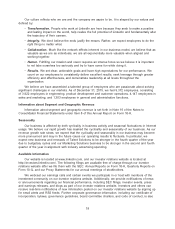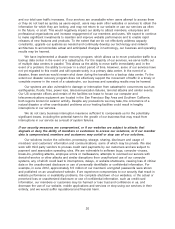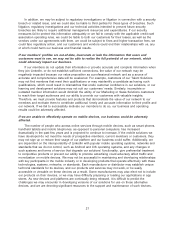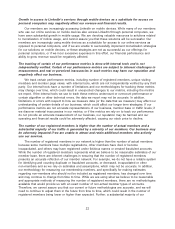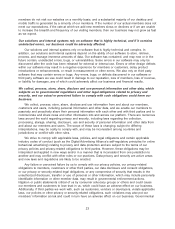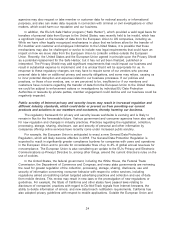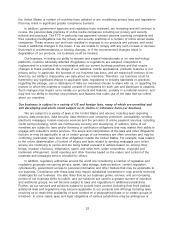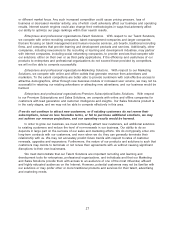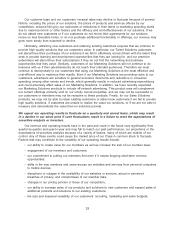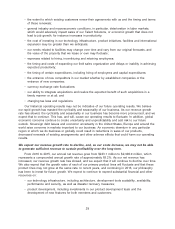LinkedIn 2015 Annual Report Download - page 22
Download and view the complete annual report
Please find page 22 of the 2015 LinkedIn annual report below. You can navigate through the pages in the report by either clicking on the pages listed below, or by using the keyword search tool below to find specific information within the annual report.and our total user traffic increases. If our services are unavailable when users attempt to access them
or they do not load as quickly as users expect, users may seek other websites or services to obtain the
information for which they are looking, and may not return to our website or use our services as often
in the future, or at all. This would negatively impact our ability to attract members, enterprises and
professional organizations and increase engagement of our members and users. We expect to continue
to make significant investments to maintain and improve website performance and to enable rapid
releases of new features and products. To the extent that we do not effectively address capacity
constraints, upgrade our systems as needed and continually develop our technology and network
architecture to accommodate actual and anticipated changes in technology, our business and operating
results may be harmed.
We have implemented a disaster recovery program, which allows us to move production traffic to a
backup data center in the event of a catastrophe. For the majority of our services, we serve traffic out
of multiple data centers in parallel. This allows us the ability to move traffic immediately and, in the
event of a problem, the ability to recover in a short period of time. However, some of our services have
not yet migrated to this model and still operate solely in a primary data center. In the event of a
disaster, these services would remain shut down during the transition to a backup data center. To the
extent our disaster recovery program does not effectively support the movement of traffic in a timely or
complete manner in the event of a catastrophe, our business and operating results may be harmed.
Our systems are also vulnerable to damage or interruption from catastrophic occurrences such as
earthquakes, floods, fires, power loss, telecommunication failures, terrorist attacks and similar events.
Our US corporate offices and certain of the facilities we lease to house our computer and
telecommunications equipment are located in the San Francisco Bay Area and Southern California,
both regions known for seismic activity. Despite any precautions we may take, the occurrence of a
natural disaster or other unanticipated problems at our hosting facilities could result in lengthy
interruptions in our services.
We do not carry business interruption insurance sufficient to compensate us for the potentially
significant losses, including the potential harm to the growth of our business that may result from
interruptions in our service as a result of system failures.
If our security measures are compromised, or if our websites are subject to attacks that
degrade or deny the ability of members or customers to access our solutions, or if our member
data is compromised, members and customers may curtail or stop use of our solutions.
Our solutions involve the collection, processing, storage, sharing, disclosure and usage of
members’ and customers’ information and communications, some of which may be private. We also
work with third party vendors to process credit card payments by our customers and are subject to
payment card association operating rules. We are vulnerable to software bugs, computer viruses,
break-ins, phishing attacks, employee errors or malfeasance, attempts to overload our servers with
denial-of-service or other attacks and similar disruptions from unauthorized use of our computer
systems, any of which could lead to interruptions, delays, or website shutdowns, causing loss of critical
data or the unauthorized disclosure or use of personally identifiable or confidential information. For
example, in June 2012, approximately 6.5 million of our members’ encrypted passwords were stolen
and published on an unauthorized website. If we experience compromises to our security that result in
website performance or availability problems, the complete shutdown of our websites, or the actual or
perceived loss or unauthorized disclosure or use of confidential information, such as credit card
information, our members or customers may be harmed or lose trust and confidence in us, and
decrease the use of our website, mobile applications and services or stop using our services in their
entirety, and we would suffer reputational and financial harm.
20


